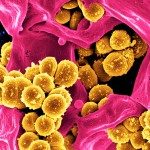Lien vers Pubmed [PMID] – 16943200
J. Biol. Chem. 2006 Oct;281(43):32188-96
The COP9 signalosome (CSN) is a conserved, multisubunit complex first identified as a developmental regulator in plants. Gene inactivation of single CSN subunits results in early embryonic lethality in mice, indicating that the CSN is essential for mammalian development. The pleiotropic function of the CSN may be related to its ability to remove the ubiquitin-like peptide Nedd8 from cullin-RING ubiquitin ligases, such as the SCF complex, and therefore regulate their activity. However, the mechanism of CSN regulatory action on cullins has been debated, since, paradoxically, the CSN has an inhibitory role in vitro, while genetic evidence supports a positive regulatory role in vivo. We have targeted expression of CSN subunits 4 and 5 in human cells by lentivirus-mediated small hairpin RNA delivery. Down-regulation of either subunit resulted in disruption of the CSN complex and in Cullin1 hyperneddylation. Functional consequences of CSN down-regulation were decreased protein levels of Skp2, the substrate recognition subunit of SCF(Skp2), and stabilization of a Skp2 target, the cyclin-dependent kinase inhibitor p27(Kip1). CSN down-regulation caused an impairment in cell proliferation, which could be partially reversed by suppression of p27(Kip1). Moreover, restoring Skp2 levels in CSN-deficient cells recovered cell cycle progression, indicating that loss of Skp2 in these cells plays an important role in their proliferation defect. Our data indicate that the CSN is necessary to ensure the assembly of a functional SCF(Skp2) complex and therefore contributes to cell cycle regulation of human cells.
